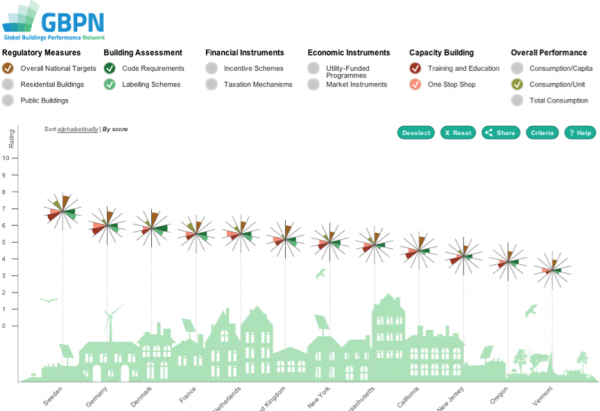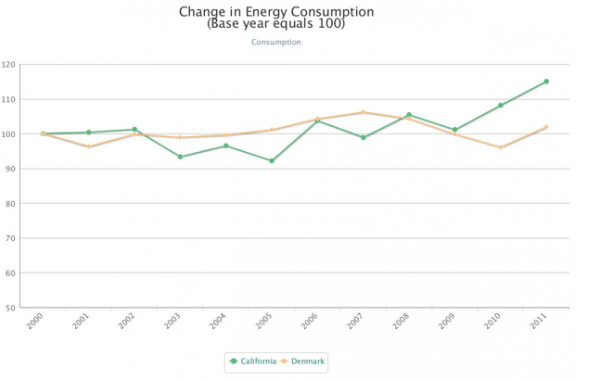Five Graphs on Current Best Practice Renovation Policies
Today, the GBPN launched a new Policy Tool for Renovation that compares best practice renovation policy packages. Learning from this comparative tool, I would like to present five graphs that illustrate some of the main outcomes of the project.
The GBPN research shows that a fundamental step needs to be taken between now and 2050: the adoption of a ”deep” scenario for our building stock, requiring a reduction in energy consumption in existing buildings of 70%. We know that this is technically possible if we implement best practice policies for renovation (that target “deep” renovation) in the next 10 years (Buildings for Our Future, GBPN, 2013).
So, what is best practice and, looking into the future, what are the essential policy elements that will enable our existing building stock to be deeply renovated?
With the help of an expert committee, the GBPN identified a detailed set of “state-of-the-art” criteria that are crucial to the development of future energy renovation policies for existing residential buildings. The criteria enabled an assessment of best practice policies, incentives and programmes that support energy renovation of buildings, more specifically ‘deep’ renovation.
Energy renovation policy is an emerging field and there is scope for further progress:
The tool shows elements where positive steps have been taken and where countries and states can learn from these actions.
Renovation policies can be adapted to include more efficient measures, this can help a jurisdiction reduce the consumption of their overall building stock and meet both their sectoral and overall energy saving targets. This graph shows the average score of each jurisdiction’s policy package (here we can see that even the highest scoring countries and states have only managed to score, on average, 5 out of the possible 10 points).

Financial mechanisms need to be locally adapted and linked to broader national renovation strategies:
Policy mechanisms varied dramatically between jurisdictions, and substantially between the EU and the US. National incentives and taxation mechanisms are widely used in the European countries whereas utility-funded and market based mechanisms are used in American states. Please see the differences between the two graphs – some mechanisms work well for some jurisdictions whereas different mechanisms work well for others.


There is no such thing as an overall “best” policy package and all countries and states can benefit from best practice sharing:
The current best practice regions use a combination of measures to complement each other – seen as a policy package. The tool shows that different combinations of measures lead to reductions in the different jurisdictions. This indicates that there are many different combinations of measures that can be used to fulfil the different needs of the individual jurisdictions, thus leading to a successful development in energy use. The figure below shows the scores for each element in Sweden’s policy package.

Although all jurisdictions studied in this project have strong policies that target energy renovation and are deemed as best practice regions globally, not all of them have been able to continually generate a steady consumption reduction in energy in the past ten years:
The graph below shows California and Denmark’s change in total energy consumption of the residential building stock between 2000 and 2011. Although both regions may have reduced their energy consumption in the past it has not continued to reduce in recent years.

Please feel free to play with the tool yourself here.
Related News
- [Tool] New Interactive Tool for Building Better Energy Renovation Policies
- [Event] New Webinar Series – How To Save Energy Using Renovation Policy Measures
- [Tool] The Policy Tool for Renovation Now Available in Chinese
- 节能改造政策工具中文版正式发布
- [Event] Webinar “Front-Runners in Energy Renovation Policies: What can we Learn from Them?”
- [Report] Webinar #1: Front Runners in Energy Renovation Policies
- [Event] Webinar: The Role of Energy Saving Targets and Regulatory Measures in Renovation Policy Packages – Key Lessons from Global Best Practices
- [Report] Webinar #2: The Role of Energy Saving Targets and Regulatory Measures in Renovation Policy Packages – Key Lessons from Global Best Practices
- [Report] A Comparative Analysis of Best Practice Renovation Policies from Europe and the United States
Share This Story, Choose Your Platform!
Stay in touch with how we’re transforming the buildings sector
GBPN runs innovative building policy reform programs in key regions around the world that aim to tackle the climate emergency by decarbonising the buildings sector. Stay up to date with our newsletter.
Stay in touch with how we’re transforming the buildings sector
GBPN runs innovative building policy reform programs in key regions around the world that aim to tackle the climate emergency by decarbonising the buildings sector. Stay up to date with our newsletter.


